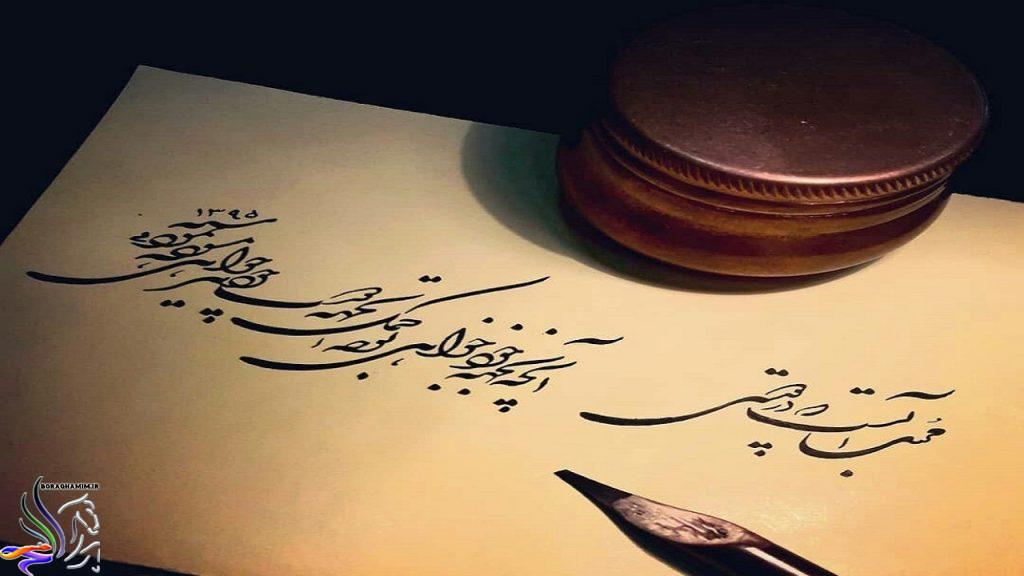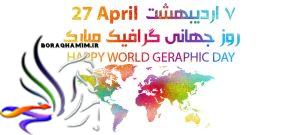The unveiling of the global registration plate of the National Program for the Protection of Calligraphy and Nasta’liq is a valuable event that took place this year at the same time as Cultural Heritage Week, to make the original position of this Iranian art in international circles more official.
Boraq Hamim news website , Farshid Baghshamal (member of Tabriz calligraphists Association) is about 600 years old from the period when “Mir Ali Tabrizi” invented Nastaliq calligraphy; An innovation that once again confirmed the role of Tabriz in destroying Iranian culture and identity. Mir Ali Tabrizi art has grown from city to city, from art schools to exhibitions and museums, and is recognized as a universal art in UNESCO.
Last December, on the fourth day of the 16th meeting of the World Committee for the Protection of Intangible Cultural Heritage, which was held online at the UNESCO site in Paris, the case of the National Program for the Preservation of Traditional Calligraphy in Iran was reviewed as the 17th Intangible Heritage Iran was registered in the UNESCO World Heritage List and soon its world registration celebration will be held in Tabriz.
The case was registered in the 16th session of the Intergovernmental Committee for the Safeguarding of the Intangible Cultural Heritage. Meanwhile, 16 Arab countries and Turkey have registered calligraphy in this period in their name.
“Knowledge, skills and methods of Arabic calligraphy” as joint files by 16 countries including Saudi Arabia, Algeria, Bahrain, Egypt, Iraq, Jordan, Kuwait, Lebanon, Mauritania, Morocco, Oman, Palestine, Sudan, Tunisia, UAE And Yemen was inscribed on the UNESCO World Heritage List.
Turkey also added “Hüsn-i Hat, traditional calligraphy in Islamic art in Turkey” to its list of intangible world cultural heritage.
Iran has also registered its calligraphy case in the list of good UNESCO protection programs for the protection of intangible heritage. Registration in the good protection programs of UNESCO means that both the intangible heritage in question will be introduced to the world and it will be well protected.
Mostafa Pour-Ali, Director General of Registration and Privacy of Works and Preservation and Restoration of Spiritual and Natural Heritage, explained in this regard: Iran is flowing and continuing. Registration of this national file, while confirming the cultural achievements of the institutions in charge of Iranian calligraphy, including government institutions and especially non-governmental organizations, has registered Iranian calligraphy in the list of intangible world heritage.
Iranian Nasta’liq flight from Tabriz to UNESCO
The “Global Registration of the National Program for the Preservation of the Art of Calligraphy” was registered as the seventeenth intangible cultural element of our country in the UNESCO World Heritage List and the plaque of this auspicious event was unveiled during the Cultural Heritage Week.
Now, if we connect this world record to the national record of “Tabriz, the origin of the Nasta’liq script” (which was registered three years ago), we can mention the brilliant role of Tabriz in the world record of Iranian calligraphy in detail.
Half-flag font
Scholars have called “calligraphy half of knowledge” due to the status that “calligraphy and calligraphy” has given to knowledge and culture, and those who have mixed calligraphy and calligraphy with poetry, architecture and carpets have said the same phrase, “calligraphy is half of love”.
Calligraphy from the first periods of evolution has so fascinated human intellect and love with its glory and beauty that the Holy Prophet (PBUH) promised forgiveness in a hadith to an artist who wrote the verse in the name of God, the Most Gracious, the Most Merciful. (Sea of Lights, vol. 1, p. 35)
From the beginning of its social course, “calligraphy” has often been synonymous with “calligraphy”. Historical real estate deeds, deeds of sale, contracts, political treaties, manuscripts, and everyday administrative writings have long been arranged, often in italics, or a combination of both.
Thus, in every historical period in which calligraphy was valued and close, the ups and downs of history have been well documented and documented, and conversely, wherever the art of calligraphy has declined, part of history has been forgotten or distorted.
But calligraphy, despite its charming subtleties, did not have an easy and simple destiny, and along with the twists and turns of history, there were many bloody and painful points in the history of this art. Evidence of this claim has been the story of “Abu Ali Muhammad Ibn Muqalla Abdullah Shirazi”, an educated Iranian minister in the court of the Abbasid Caliphate.

The only work left by Ibn Muqalla, an Iranian calligraphist skilled in the Abbasid Caliphate
Ibn Muqalla, the calligraphist killed by the Abbasid Caliphate
Ibn Muqalla’s historical fame is not due to his political positions, but to his invention of the six lines and the establishment of the twelve principles of calligraphy.
Ibn Muqalla has been the minister of the Abbasid court in three historical periods and has been dismissed each time in opposition to the tyranny of the Abbasid caliphs. He is one of the few well-known Abbasi ministers known for his prudence, fairness and wisdom, and wrote three Qurans during his artistic life. He perfected the Islamic script from the difficult Kufi to the beautiful and fluent version and established the twelve principles of calligraphy (composition, chair, ratio, weakness, strength, level, distance, virtual ascent, virtual descent, principles, purity and dignity).
Were it not for his artistic endeavor, manuscripts would have been lost as one of the main sources of all Islamic and Iranian scripts, and it would have been very difficult to understand Islamic texts (including the Qur’an, hadith, and the works of renowned historians).
However, one day when Razia Ballah, the tyrannical Abbasid caliph, learned of Ibn Muqalla’s correspondence with one of the opposition leaders, he ordered that his hand be amputated from his elbow. Whatever Ibn Muqalla did to eliminate the art of calligraphy with the implementation of this ruling, the Caliph did not listen and finally, by cutting off Ibn Muqalla’s hand, Dajkhim Abbasi made one of the shameful phrases in the history of art.
Master Naskh was depressed for a while and squeezed his amputated hand in his chest and cried. It is said that he used to hold a stick on his elbow and do calligraphy for a while. Later, he continued calligraphy with his left hand. But his tongue was still red and he did not stop accompanying the oppressed people until his tongue was cut off and imprisoned by the order of the caliph. He was in prison for some time until he died in 327 AH. The oppression of the society was such that even his grave was exhumed and moved several times.
The assassination of Ibn Muqalla delayed the progress of the Naskh script and did not allow the mysteries and delicacies that this master of art had acquired through much research and practice to be revealed in his time frame. Brought art to flourish in later periods.

A leaf from the divan of Sultan Ahmad Jalayer, in Mir Ali script of Tabriz
Tabriz’s creative art in the Caliphate of Baghdad
The history of Islamic and Iranian calligraphy, after the assassination of Ibn Muqalla, had an almost constant course for several centuries and lacked a fundamental change. Until in the middle of the ninth century AH, “Mir Ali Tabrizi” removed the “suspension line” which had a difficult and twisted style from the monopoly of the court and the madman, and after combining it with the abrogation, created the Nasta’liq line with an independent identity and personality. .
The exact details of Mir Ali’s life are not known, but in some treatises it is said that Mir Ali inspired Nastaliq’s arches and stretches in the dream world and from the flight of geese in the sky.
Mir Ali was at the court of Sultan Ahmad Jalayr in Baghdad for some time. “Khajavi Kermani” is one of the works of this period that is kept in the British Library Museum today.
Thus, the path that Mir Ali begins in Tabriz will soon come to life in Baghdad, Persia and Khorasan, until a century later, the famous figure of Nastaliq history emerges from Qazvin: “Mir Emad Hassani”

Surah Hamad is one of the famous works of Mir Emad
Mir Emad, student of Tabriz school and martyr of Nastaliq
As a young man, Mir Emad traveled from Qazvin to Tabriz to complete his art and benefited from the teachings of the famous master of the time, Mullah Mohammad Hossein Tabrizi. It is said that Mir Emad one day showed a piece of his line to Mullah Mohammad Hossein Tabrizi; The teacher said, “If you can write like that, write, otherwise drop the pen.” “I wrote it myself,” said Mir. The master kissed him on the face and put his handwriting on his eyes and said: “Today you are the master of calligraphists” and considered him a needless student.
Mir Emad then went to Isfahan and was supported by the Safavid Shah. Mir Emad in Isfahan, by studying and researching the works of his predecessors, polished the geometry of the calligraphic components and brought the letters and drawings to the most accurate artistic structure. Mir Emad’s angles are so consistent with the principles of aesthetics that the audience sees themselves in the face of a creative engineer and calculator. However, what makes this a source of elegance and beauty is the strong sense, the level of virtue and the purity of the soul in an artist like Mir Emad.
This caused the fame of his calligraphy to reach our Iran and reach far away Hejaz, India and Ottoman; At a time when there was no news of copiers and photos! Mir Emad’s calligraphy was traded with Yemeni agate and Indian diamonds, and the Shah of India was determined to give Mir Emad’s gold to the Safavid court in order to obtain it.
Unfortunately, the presence of Mir Emad in the Safavid court had a bitter end. As Mir Emad’s popularity soared, jealousies and slanders against him began. It was rumored that Mir Emad had turned away from the Shiites and was slandering the Shah. Mir Emadi, who was from Sadat Hassani and due to his special devotion to Imam Hassan Mojtaba (AS), mentioned the title “Al-Hassani” in most of his works.
The night Mir Emad was about to take a bath, court thugs attacked him and killed him. The political atmosphere against Mir was so bleak that even his dismembered body remained on the ground for several days and no one dared bury him. Shortly afterwards, one or two of his disciples buried his body in the Dark Mosque of Isfahan.

Alireza Abbasi Tabrizi badge, in one of Nastaliq works
Alireza Abbasi-Tabrizi, The writing of love in the inscription of Razavi dome (AS)
Another brilliant figure in the history of calligraphy and calligraphy is “Alireza Abbasi Tabrizi”. Abbasi was born in Tabriz and is nicknamed “Shahnavaz”. Like Mir Emad, he studied calligraphy in Tabriz with “Mullah Mohammad Hossein Tabrizi” and later turned to calligraphy and manuscripts. After the conquest of Tabriz by the Ottomans, he went to Qazvin, the capital of the Safavid state, and took up residence in the city’s Grand Mosque, where he began to write and finish some of the inscriptions of that mosque.
Alireza gradually became one of the Shah’s special nephews, so much so that the Shah hired a group of calligraphists such as Mohammad Reza Emami Isfahani, Mohammad Saleh Isfahani, and Abdul Baqi Tabrizi to learn the third line under him. Abbasi was among the Shah’s most trusted relatives until the end of his life, and the friendship between him and Shah Abbas continued until the end of his life.

The inscription of the copy of the Razavi Dome (AS), the most important masterpiece of Alireza Abbasi Tabrizi, is a calligraphist of the Safavid period.
The most famous work that remains of “Alireza Abbasi Tabrizi” is the blue inscription on the dome of Imam Reza (AS). The third inscriptions on the entrance and the large inscription inside the dome of Sheikh Lotfollah Mosque are also the work of this Tabrizi artist. The inscription on the entrance of the Imam (Shah) Mosque in Isfahan was also written by Abbasi. The year of death of Alireza Abbasi-Tabrizi has been recorded as 1038 AH, but there is no sign of his burial.
It is noteworthy that “Alireza Abbasi Tabrizi” should not be confused with “Reza Abbasi”. “Reza Abbasi” is a famous painter of the Safavid and contemporary periods with Alireza.

Tile inscription in the third line of Alireza Abbasi-Tabrizi in Imam Mosque of Isfahan
This article looked at the major contribution of Tabriz in the evolution of calligraphy. Faces that are more famous in the field of calligraphy, but perhaps some of the audience in the field of culture are not aware of the Tabrizi originality of their art. Other prominent Tabrizi pioneers in the field of calligraphy are Mirza Jafar Tabrizi, Azhar Tabrizi, Mohammad Hossein Tabrizi and Mir Haidar Hosseini Tabrizi, whose role in the evolution of calligraphy can be the subject of extensive articles and reports.
Sources:
– Iranian ministers imprisoned and killed, from Umayyads to Safavids / Bijan Keshavarz / 1397
– Atlas of Calligraphy, Research in Islamic Calligraphy / Habibollah Fazaeli / 2011
End of message /
Source: Fars News






More Stories
Mohammad Sadiq Saif
An exhibition named “In the name of Majesty Mother”
Calligraphy is a successful example of Art in propagating the word of revelation and decorating it